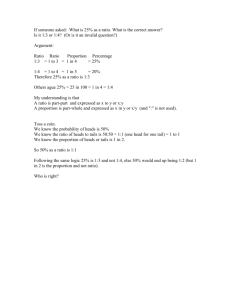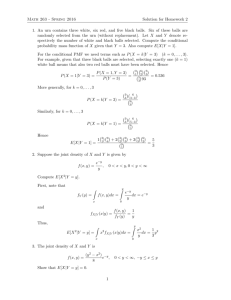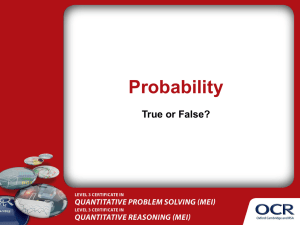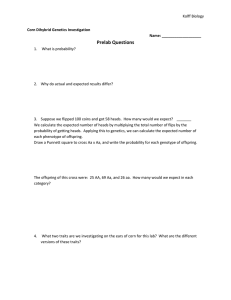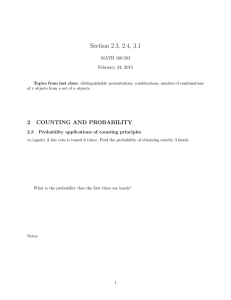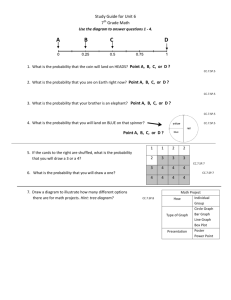ANALYSIS OF THE CHOW-ROBBINS GAME JON LU May 10, 2016
advertisement
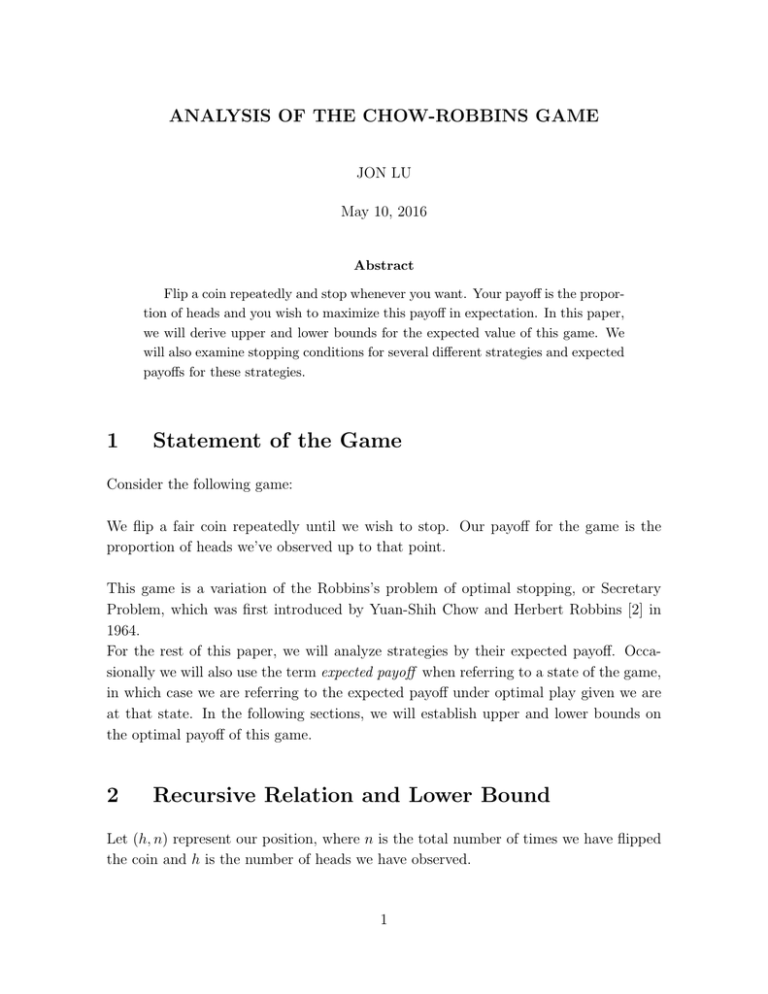
ANALYSIS OF THE CHOW-ROBBINS GAME
JON LU
May 10, 2016
Abstract
Flip a coin repeatedly and stop whenever you want. Your payoff is the proportion of heads and you wish to maximize this payoff in expectation. In this paper,
we will derive upper and lower bounds for the expected value of this game. We
will also examine stopping conditions for several different strategies and expected
payoffs for these strategies.
1
Statement of the Game
Consider the following game:
We flip a fair coin repeatedly until we wish to stop. Our payoff for the game is the
proportion of heads we’ve observed up to that point.
This game is a variation of the Robbins’s problem of optimal stopping, or Secretary
Problem, which was first introduced by Yuan-Shih Chow and Herbert Robbins [2] in
1964.
For the rest of this paper, we will analyze strategies by their expected payoff. Occasionally we will also use the term expected payoff when referring to a state of the game,
in which case we are referring to the expected payoff under optimal play given we are
at that state. In the following sections, we will establish upper and lower bounds on
the optimal payoff of this game.
2
Recursive Relation and Lower Bound
Let (h, n) represent our position, where n is the total number of times we have flipped
the coin and h is the number of heads we have observed.
1
From (h, n), we have two choices: stop or continue.
If we stop, we receive h/n in payoff.
If we continue, with 1/2 probability we end up at (h, n + 1) and with 1/2 probability
we end up at (h + 1, n + 1).
Thus, if we let V (h, n) denote our expected payoff from (h, n), we have the following
recursive relation:
h V (h, n + 1) + V (h + 1, n + 1)
V (h, n) = max
,
.
(1)
n
2
At first glance this may seem like a standard recursion but upon closer inspection we
notice something strange: each V (h, n) depends on terms with successively larger n, so
the “base case” for this recursion is V (h, ∞), which we can’t compute!
To get around this problem, we will choose a “horizon” N such that we find lower bounds
for all V (h, N ) and then recursively apply (1) to get lower bounds for all V (h, n), n < N .
We can think of N as the cutoff point where we cease to use the recursive formula (1)
and as a result don’t compute any of the terms V (h, n), n > N .
To obtain a lower bound, notice that at position (h, n), we can guarantee h/n by
stopping. Moreover, if h/n < 1/2, we can wait until the proportion of heads is at least
1/2 to stop which occurs with probability 1.1 Thus, we attain the following simple
lower bound:
h 1
,
.
(2)
V (h, n) ≥ max
n 2
While this lower bound holds in general, for smaller values of n it is not very tight
and so we will avoid using it when possible. Choosing a larger horizon N to apply the
lower bound from (2) on gives a tighter bound on each of the V (h, n)s after recursing.
As N approaches infinity, the lower bound we obtain for each V (h, n) approaches the
true value. Using N = 107 , Häggström and Wästlund [1] compute the following lower
bound:
V (0, 0) > 0.79295301
(3)
3
Upper Bound on V (h, n)
The following section is motivated by Häggström and Wästlund [1].
Let Ṽ (h, n) be the expected payoff from position (h, n) under infinite clairvoyance,
1
For a rigorous proof, see Theorem 4.2.
2
i.e., we have complete knowledge of the results of all future coin flips and Ṽ (h, n) is the
largest proportion of heads ever attained.
Since we know that V (h, n) ≤ Ṽ (h, n), any upper bound on Ṽ (h, n) is necessarily
an upper bond on V (h, n). In order to establish an upper bound on Ṽ (h, n), we first
prove the following:
Let P (h, n, p) be the probability that ∃ m, m ≥ n such that the proportion of heads
in the first m flips exceeds p. P (h, n, p) can also be thought of as the probability that
starting from (h, n), at some point now or in the future the overall proportion of heads
exceeds p.
Let k = k(h, n, p) be the minimum number of coin flips from (h, n) for which it is
possible to achieve an overall proportion of heads exceeding p in k more flips. For
example, k(1, 3, 0.5) = 2 and k(2, 3, 0.5) = 0.
Lemma 3.1.
P (h, n, p) ≤
1
(2p)k
Proof. One can check that if p ≤ max(a/n, 1/2), the statement holds. If p < a/n or
p ≤ 1/2, the RHS 1/(2p)k ≥ 1. The case of p = a/n is left as an exercise for the reader.
Consider Pr (next k flips are heads | proportion p will eventually be exceeded). On
one hand,
P r(next k flips are heads | proportion p eventually exceeded)
=
=
=
(4)
P r(next k flips are heads ∩ proportion p eventually exceeded)
proportion p eventually exceeded
P r(next k flips are heads )
proportion p eventually exceeded
(1/2)k
,
P (h, n, p)
(5)
where the second equality holds because the next k flips being heads guarantees that a
proportion p of heads will eventually be exceeded.
However, we can also establish a lower bound for this probability. In (4), we condition on the existence of an m ≥ n for which the proportion of heads in the first m
3
flips exceeds p. Since we assumed p > 1/2, we know by the Weak Law of Large Numbers that with probability 1 there exists a maximal m = M for which the first m coin
flips have a proportion greater than p of heads.
Because we are operating under infinite clairvoyance, we know the value of M and so
we also know the exact number of heads H in flips n + 1, n + 2, ..., M . Furthermore, we
know that all permutations of those M − n flips containing H heads are equally likely
by symmetry.
Consider flip n + 1. If k > 1, the proportion of heads up to this point is less than or
equal to p but at flip M exceeds p so the proportion of heads q1 among flips n + 1, ...,
M necessarily exceeds p. Since flip n + 1 is just as likely as any of flips n + 2, ..., M of
being among the q1 > p that are heads, the probability that flip n + 1 is heads is q1 > p.
Similarly, consider flip n + 2. Conditioned on flip n + 1 being heads, the proportion of
heads up to this point is still at most p but exceeds p at flip M . If we let q2 be the
proportion of heads among flips n + 2, ..., M , we know q2 > p and consequently the
probability of flip n + 2 being heads given flip n + 1 is heads is greater than p.
Continuing this argument for i = 3, ..., k, we have that flip x+i has a probability greater
than p of being heads given flips x + 1, ..., x + i − 1 were heads. Thus, the conditional
probability of flips x + 1, ..., x + k being heads
P r(next k flips are heads | proportion p eventually exceeded) ≥ pk .
(6)
Combining (5) and (6) and rearranging gives the desired result.
Theorem 3.2.
Ṽ (h, n) ≤ max
h 1
,
n 2
r
1 π
1
+ min
,
.
4 n 2 · |2h − n|
(7)
Proof. The following derivation is reproduced from Häggström and Wästlund [1].
From the inverse-CDF definition of expected value, we have:
Z 1
Ṽ (h, n) =
P (h, n, p)dp
0
Z 1
h 1
= max
,
+
P (h, n, p)dp
h 1
n 2
max( n
,2)
By definition, k satisfies
h+k−1
≤p
n+k−1
which reduces to
k ≤1+
np − h
.
1−p
4
(8)
Furthermore, k is the largest integer that satisfies (8) so we have:
k≥
np − h
.
1−p
(9)
Substituting (9) into Lemma 3.1. yields:
1
P (h, n, p) ≤
(2p)
It follows that
Ṽ (h, n) ≤ max
h 1
,
n 2
Z
np−h
1−p
1
dp
+
h 1
,2)
max( n
(2p)
np−h
1−p
.
(10)
Substituting p = (1 + t)/2 and using the well-known inequality
log(1 + t)
≥ t,
1−t
(10) simplifies to
Ṽ (h, n) ≤ max
h 1
,
n 2
1
+
2
Z
1
dt
(1+t)n−2h
max( 2h−n
,0)
n
(1 + t) 1−t
Z 1
h 1
1
(1 + t)n − 2h
= max
,
+
· log(1 + t) dt
exp −
n 2
2 max( 2h−n
1
−
t
,0
)
n
Z 1
h 1
1
≤ max
exp(−(1 + t)tn + 2ht)dt
,
+
n 2
2 max( 2h−n
,0)
n
√
Using the substitution u = t n, we obtain:
Z √n
2h − n
h 1
1
2
√
Ṽ (h, n) ≤ max
,
+ √
· u du
exp −u +
n 2
2 n max 2h−n
n
√
,0
n
Z ∞
h 1
1
2h − n
2
√
≤ max
,
+ √
· u du
(11)
exp −u +
n 2
2 n max 2h−n
n
√
,0
n
√
Using the substitution w = u − (2h − n)/ n,
Z ∞
Z ∞
2h − n
2h − n
2
2
exp −u + √
· u du =
exp −w − √
· w dw
2h−n
n
n
√
0
(12)
n
From (11) and (12), we can check that
Z ∞
h 1
1
|2h − n|
2
Ṽ (h, n) ≤ max
,
+ √
exp −u − √
· u du.
n 2
2 n 2h−n
n
√
n
5
(13)
Furthermore, by discarding terms from the integral in (13), we have
Z ∞
Z ∞
1
|2h − n|
1
2
√
exp −u − √
· u du ≤ √
exp −u2 du
2 n 2h−n
n
2 n 2h−n
√
√
n
n
r
1 π
=
4 n
(14)
and
1
√
2 n
Z
∞
2h−n
√
n
Z ∞
|2h − n|
|2h − n|
1
2
exp −u − √
exp − √
· u du ≤ √
· u du
n
2 n 2h−n
n
√
n
1
.
=
2 · |2h − n|
Combining (14) and (15), we have
r
Z ∞
1 π
1
1
|2h − n|
2
√
· u du ≤ min
,
exp −u − √
4 n 2 · |2h − n|
2 n 2h−n
n
√
(15)
(16)
n
Substituting (16) into (13) gives the desired result.
To compute an upper bound on Ṽ (0, 0), we turn to the a similar strategy to the one
we used to calculate a lower bound. In particular, we will use Theorem 3.2 to compute
upper bounds on terms of the form Ṽ (h, N ) for some large N , from which we also have
upper bounds on the V (h, N )s. We will then apply our fundamental recursive relation
from (1) to compute upper bounds on all V (h, n), n < N . Using N = 107 gives the
upper bound [1]:
V (0, 0) < 0.79295560
(17)
Lastly, combining the lower bound (3) we derived earlier with this upper bound (17)
gives us fairly tight bounds on the expected value of the game under optimal play:
0.79295301 < V (0, 0) < 0.79295560
4
(18)
Strategies for Playing the Game
Now that we’ve derived bounds on the expected payoff of this game, it’s worth examining some different strategies and to see how they fare in comparison.
We will find the following results helpful in our analysis of these strategies:
6
Lemma 4.1. If we flip a fair coin forever, the probability of at some point obtaining k more heads than tails or k more tails than heads is 1 for all values of k.
Proof. Let hn be the number of heads and tn be the number of tails we observe in
the first n flips respectively. Let dn = hn − tn be the heads-tails differential after n flips.
We are trying to show that with probability 1, |dn | = k for some n. The key realization we make is that if |dN | < k, flipping 2k heads or 2k tails in a row causes
|dN +2k | > k, which means for some value of n ∈ {N + 1, ..., N + 2k − 1}, |dn | = k. Thus,
in order for the condition of |dn | < k to hold for all n, we can never flip 2k heads or 2k
tails consecutively.
We now consider blocks of 2k flips at a time. The probability that we avoid flipping
k
2k consecutive heads or 2k consecutive tails within the first 2k flips is simply 2 2−2
k .
Likewise, this is also true for the next 2k flips, the 2k flips after that, etc. Thus, the
probability that in the first b blocks of 2k flips each, no individual block contains all
heads or all tails is
!b
22k − 2
.
22k
As b goes to infinity, this expression goes to 0, so the probability that some block contains 2k heads or 2k tails is 1, completing the proof.
Theorem 4.2. [Simple Random Walks] If we flip a fair coin forever, the probability of at some point obtaining k more heads than tails is 1 for all values of k.
Proof. Reusing our notation from Lemma 4.1, we seek to show that with probability 1, dn = k for some n. From Lemma 4.1, we know that with probability 1, |dn | = k
for some n. By symmetry, dn is equally likely to reach k or −k first. Thus, with probability 1/2, dn reaches k first and we are done. With probability 1/2, dn reaches −k
first. However, reapplying this argument, the heads-tails differential starting from the
n + 1-th flip is equally likely to reach 2k or −2k. With probability 1/2, it reaches 2k
first, resulting in dn = −k + 2k = k, in which case we are done. With probability 1/2, it
reaches −2k first, causing dn = −k − 2k = −3k, in which case we repeat the argument
again. Thus, the probability of dn = k at some point is:
1 1 1 1 1 1
+ · + · · + · · · = 1.
2 2 2 2 2 2
This completes the proof.
7
The first strategy we will consider is a very simple strategy:
Strategy 4.3.1 If the first flip is heads, stop. If it is tails, flip until the number
of heads equals the number of tails.
Analysis. With probability 1/2, we flip heads and our payoff is 1 and with probability
1/2 we flip tails and eventually receive a payoff of 1/2 (we can guarantee termination
because of Theorem 4.2). Thus the expected payoff of this strategy is just
E=
1 1
3
1
·1+ · = .
2
2 2
4
(19)
Notice that this simple strategy actually does reasonably well compared to the bound
obtained in (18).
We now consider a more interesting strategy:
Strategy 4.3.2 Stop when the number of heads first exceeds the number of tails.
Analysis. We first note that termination is guaranteed since this corresponds to k = 1
from Theorem 4.2. We also note that termination will always occur on an odd numbered
flip. With this in mind, the expected payoff of this strategy is then
E=
∞
X
p2n+1 ·
n=0
n+1
,
2n + 1
where p2n+1 is the probability we terminate on the 2n + 1-th flip and (n + 1)/(2n + 1)
is our payoff from terminating on the 2n + 1-th flip.
We now try to compute p2n+1 :
p2n+1 =
# of ways to terminate on 2n + 1-th flip
# of possibilities for first 2n + 1 flips
(20)
Clearly, the denominator of (20) is just 22n+1 . To compute the numerator, notice that
the terminating flip will always be a head since if it were tails we would have terminated
sooner. Thus, computing the numerator reduces to finding the number of sequences
X1 , ..., X2n containing exactly n heads and n tails such that for no i ∈ {1, ..., 2n} does
X1 , ..., Xi contain more heads than tails – this last condition prevents early termination.
8
However, this is equivalent to the number of Dyck paths2 of length 2n, which is known
to be the n-th Catalan number Cn . Thus, we have:
E=
∞
X
p2n+1 ·
n=0
n+1
2n + 1
∞
X
Cn
n+1
·
=
2n+1
2
2n + 1
n=0
∞
1X
1
2n
=
2n
2 n=0 2 (2n + 1) n
1
= arcsin(1)
2
π
= .
4
Note that π/4 ≈ 0.7854, so this is remarkably close to the bounds obtained in (18).
Comment: Because of Theorem 4.2, all strategies of the form “stop when the number of heads first exceeds the number of by tails by k” are valid, i.e., terminate with
probability 1. It turns out that the strategy above (k = 1) has the highest expected
value out of all strategies in this family.
Question to the reader: Intuitively why does this make sense?
5
Further Exploration
As of today, no known strategy has an expected payoff within the bounds we derived
(18) and so an optimal strategy has not yet been discovered. To my knowledge, the
tightest known bounds for the expected value of this game are given by Julian Wiseman [3], who used a larger horizon of N = 228 . Possible areas for research would be
improving these bounds either through increased computational power or by using a
more computationally efficient bounding strategy. Another possible extension of this
problem which was suggested by a classmate was to repeat the same analysis we performed but for biased coins with probability p 6= 1/2 of landing heads.
2
Sequences containing equal numbers of up and down steps in which every prefix has at least as
many up steps as down steps.
9
References
[1] Olle Häggtröm and Johan Wästlund, Rigorous computer analysis of the ChowRobbins game, The American Mathematical Monthly 120(10): 893-900 (2013)
[2] Yuan-Shih Chow and Herbert Robbins, On optimal stopping rules for sn /n, Ill. J.
Math., 9: 444-454, 1965.
[3] Julian D. A. Wiseman, The Chow & Robbins Problem: Stop at h=5, t=3, web page,
http://www.jdawiseman.com/papers/easymath/chow robbins.html
10
